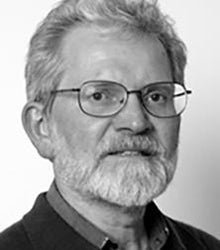
James Tice
MArch (Urban Design) Cornell University, 1970
BArch Cornell University, 1968
Registered Architect: California
Additional Website:
Interactive Nolli Map Website
Professor Jim Tice views architecture as a humanist discipline that opens an understanding of the world to generate positive change. In addition to teaching studios at every level of the curriculum he teaches a foundational course in spatial composition, and seminars on the façade, Frank Lloyd Wright, the Italian Palazzo, Le Corbusier, and the architecture and urbanism of Rome.
Tice's scholarship is based on his belief that making connections between theory and practice, and idea and form, should be central to the mission of every architect. His interest in the legibility of urban form focused on the first accurate map of Rome, produced in 1748 by Giambattista Nolli. This investigation led Tice to create interactive tools that facilitate the study of Rome using a seamless digitization of the historic map. Tice developed the Interactive Nolli Map Website in collaboration with Erik Steiner of the UO InfoGraphics Lab and Alan Ceen of Studium Urbis in Rome attracted attention from the Christian Science Monitor, the London Times and Corriere delle Sera, the Italian newspaper published in Milan. The Nolli Map Website received awards from the online planning and development network Planetizen for giving universal access to a discovery of the evolution of the city through primary source material and the Nortwest Academic Computing Consortium.
Tice has continued the project by geo-referencing the 1748 map with more than 240 perspectives drawn by 18th century artist Giuseppe Vasi linking them with contemporary photographs by the author. The result is the Imago Urbis: Giuseppe Vasi’s Grand Tour of Rome website, which transports virtual tourists through space and time to explore the architecture and urban design of Rome. Developed with Steiner, and Ceen, the site was funded by the John Paul Getty Foundation. This line of inquiry resulted in a traveling exhibition and accompanying catalogue which he curated with James Harper, associate professor of Art History entitled Lasting Impressions from the Age of the Grand Tour. The show and catalogue was funded, respectively, by the Samuel H. Kress Foundation and the Graham Foundation. His current collaborative research focuses on the digital representation of the archeological foundations of Rome. To this end he has received a Digital Implementation Fellowship from the American Council of Learned Societies for The GIS Forma Urbis Romae Project: Creating a Layered History of Rome.
Another of Tice’s continuing interests lies in the typological significance and social implications of housing form. Following the publication of Courtyard Housing in Los Angeles (Princeton Architectural Press, 2nd ed. 1992), co-authored with Stefanos Polyzoides and Roger Sherwood and funded by the National Endowment for the Arts, he was active in promoting historic preservation initiatives for this housing type in West Hollywood and Santa Monica. Tice also served as editor for the American section on housing for The Socially Responsible Environment: USA/USSR 1980-1990 (Architects Designers Planners for Social Responsibility and the USSR Union of Architects, 1990).
Tice is the recipient of a citation of merit from the AIA Architectural Education Initiative for his 1987 publication, Principles of Architectural Design, completed as an associate professor at Columbia University. He has also collaborated with Paul Laseau to explore Wright's work from a typological point of view in Frank Lloyd Wright: Between Principle and Form (Van Nostrand Reinhold, 1992). His scholarship has appeared in The Journal of Architectural Education, Metamorfosi, Architectural Design, Casabella,and Dimensions (University of Michigan).
Tice worked in the offices of Richard Meier and Partners, Studio Seven, and Whiting Associates in Rome before founding Coastal Architects in Eugene with Virginia Cartwright. He served as urban design consultant for the Federal Courthouse District in Eugene and designer for the Festival Gate in Junction City, Oregon. Tice has led and collaborated on award-winning competition entries appearing in publications including Progressive Architecture, LA Architect, Japan Architect, and Vacant Lots (Princeton Architectural Press). He also created a traveling exhibit, “On Common Ground: Four Housing Projects by James Tice,” recognized by the Association of Collegiate Schools of Architecture for design excellence in promoting architecture and research as a reflective discipline. His work has been exhibited at the National Academy of Design and selected drawings are part of the permanent collection in the Avery Centennial Drawings Archive at Columbia University.
Tice came to the University of Oregon in 1991 as the Willard K. Martin Visiting Professor and joined the faculty in 1992. He was previously an associate professor at Columbia University. He has led summer programs in Rome for architecture programs including Columbia University, Parsons School of Design, and the University of Oregon. He has also taught in Rome as academic director for the University of Notre Dame, and in Siena, Italy, as faculty director for the Northwest Council on Study Abroad. Tice has been invited to universities throughout the United States and Europe as a guest lecturer and critic and has taught as a visiting professor at the University of Pennsylvania, the New York Institute of Technology, the University of Michigan, Cornell University, Ohio State University, and an International Program on Solar Architecture in Urbino, Italy. He also held posts at the University of Southern California and at Ohio University. Tice serves on the board of advisors for the Frank Lloyd Wright Gordon House Conservancy in Silverton, Oregon.
